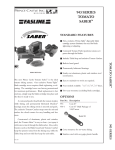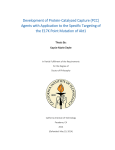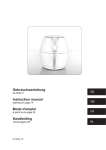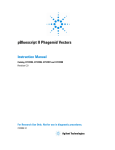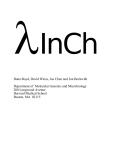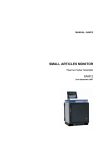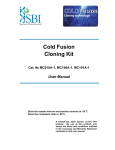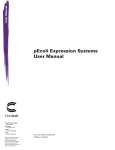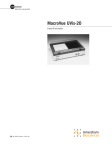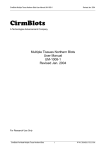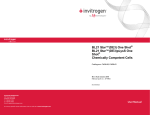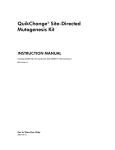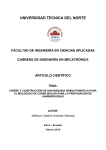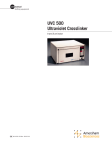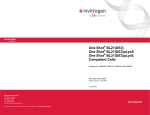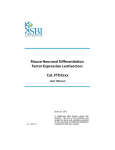Download Manual: Lambda DASH Library
Transcript
Lambda DASH Library INSTRUCTION MANUAL Revision A BN #943801-12 For In Vitro Use Only 943801-12 LIMITED PRODUCT WARRANTY This warranty limits our liability to replacement of this product. No other warranties of any kind, express or implied, including without limitation, implied warranties of merchantability or fitness for a particular purpose, are provided by Agilent. Agilent shall have no liability for any direct, indirect, consequential, or incidental damages arising out of the use, the results of use, or the inability to use this product. ORDERING INFORMATION AND TECHNICAL SERVICES United States and Canada Agilent Technologies Stratagene Products Division 11011 North Torrey Pines Road La Jolla, CA 92037 Telephone (858) 373-6300 Order Toll Free (800) 424-5444 Technical Services (800) 894-1304 Internet [email protected] World Wide Web www.stratagene.com Europe Location Telephone Fax Technical Services Austria 0800 292 499 0800 292 496 0800 292 498 Belgium France Germany Netherlands Switzerland United Kingdom 00800 7000 7000 00800 7001 7001 00800 7400 7400 0800 15775 0800 15740 0800 15720 00800 7000 7000 00800 7001 7001 00800 7400 7400 0800 919 288 0800 919 287 0800 919 289 00800 7000 7000 00800 7001 7001 00800 7400 7400 0800 182 8232 0800 182 8231 0800 182 8234 00800 7000 7000 00800 7001 7001 00800 7400 7400 0800 023 0446 +31 (0)20 312 5700 0800 023 0448 00800 7000 7000 00800 7001 7001 00800 7400 7400 0800 563 080 0800 563 082 0800 563 081 00800 7000 7000 00800 7001 7001 00800 7400 7400 0800 917 3282 0800 917 3283 0800 917 3281 All Other Countries Please contact your local distributor. A complete list of distributors is available at www.stratagene.com. Lambda DASH Library CONTENTS Materials Provided.............................................................................................................................. 1 Storage Conditions .............................................................................................................................. 1 Additional Materials Required .......................................................................................................... 1 Host Strains and Genotypes ............................................................................................................... 1 Introduction......................................................................................................................................... 2 Preparation of Host Cells ................................................................................................................... 3 Preparation of a –80°C Glycerol Stock ................................................................................. 3 Preparation of Plating Cultures......................................................................................................... 4 Day 1 ..................................................................................................................................... 4 Day 2 ..................................................................................................................................... 4 Titering Procedure .............................................................................................................................. 4 Amplification Procedure (optional)................................................................................................... 5 Day 1 ..................................................................................................................................... 5 Day 2 ..................................................................................................................................... 5 Day 3 ..................................................................................................................................... 5 DNA Screening Protocol..................................................................................................................... 6 Prehybridization .................................................................................................................... 7 Hybridization......................................................................................................................... 8 Hybridization Solution .......................................................................................................... 8 Washes................................................................................................................................... 9 Exposure to Film ................................................................................................................. 10 Secondary Screening......................................................................................................................... 10 Tertiary Screening ............................................................................................................................ 10 Phage Preparations ........................................................................................................................... 11 Making End-Specific RNA Probes Using the Lambda DASH Vector ......................................... 11 Transcription ....................................................................................................................... 12 Rapid Restriction Mapping.................................................................................................. 12 Preparation of Media and Reagents ................................................................................................ 13 Reference............................................................................................................................................ 14 Endnotes............................................................................................................................................. 14 MSDS Information............................................................................................................................ 14 Lambda DASH Library MATERIALS PROVIDED Material provided Quantity Amplified premade library constructed in the Lambda DASH vector a 1 ml Host strainsc a XL1-Blue MRA strain 0.5-ml bacterial glycerol stock XL1-Blue MRA (P2) strain 0.5-ml bacterial glycerol stock Premade libraries have been amplified one time and frozen in the presence of 7% DMSO. Upon arrival, store at –80°C. Do not pass through more than two freeze–thaw cycles. STORAGE CONDITIONS Premade Library: –80°C Bacterial Glycerol Stocks: –80°C ADDITIONAL MATERIALS REQUIRED 14-ml BD Falcon polypropylene round-bottom tubes (BD Biosciences Catalog #352059) Sonicated salmon sperm DNA (100 μg/ml; Stratagene Catalog #201190) NucTrap probe purification columns [(Stratagene Catalog #400701 (25 columns) and #400702 (50 columns) HOST STRAINS AND GENOTYPES Host Strains Genotypes XL1-Blue MRA Δ(mcrA)183 Δ(mcrCB-hsdSMR-mrr)173 endA1 supE44 thi-1 gyrA96 relA1 lac XL1-Blue MRA (P2) XL1-Blue MRA (P2 lysogen) Revision A Lambda DASH Library © Agilent Technologies, Inc. 2009. 1 INTRODUCTION The Lambda DASH vector is a versatile genomic replacement lambda phage vector designed to allow high-resolution restriction mapping and rapid chromosomal walking without subcloning. The vector accepts inserts from 9 to 23 kb. The Lambda DASH system takes advantage of spi (sensitive to P2 inhibition) selection. Lambda phages containing active red and gam genes are unable to grow on host strains that contain P2 phage lysogens. Lambda phages without these genes are able to grow on strains lysogenic for P2 such as XL1-Blue MRA (P2), a P2 lysogen of XL1-Blue MRA. The red and gam genes in the Lambda DASH DNA are located on the stuffer fragment; therefore, the wild-type Lambda DASH phage cannot grow on XL1-Blue MRA (P2). When the stuffer fragment is replaced by an insert, the recombinant Lambda DASH DNA becomes red–/gam–, and the phage is able to grow on the P2 lysogenic strain. Therefore, by plating the library on the XL1-Blue MRA (P2) strain, only recombinant phages are allowed to grow. The strain XL1-Blue MRA is also provided as a control strain and later for growth of the recombinant when the selection is no longer necessary. Digestion with Sal I allows excision of the insert and flanking T3 and T7 bacteriophage promotors as an intact cassette. T3 and T7 promotors flanking the insertion sites can be used to generate end-specific RNA probes for use in chromosomal walking and restriction mapping. FIGURE 1 Map of the Lambda DASH replacement vector. 2 Lambda DASH Library PREPARATION OF HOST CELLS The host strains have been sent as glycerol stocks. For the appropriate media and plates, please refer to the following table: Note The strains XL1-Blue MRA and XL1-Blue MRA (P2) have been modified to enhance the stability of clones containing methylated DNA; in addition, they enhance the stability of nonstandard DNA structures. Media for bacterial cultures for titering phage (final concentration) Bacterial strain Plates for bacterial streak§ Media for glycerol stock§ XL1-Blue MRA (P2) LB LB LB with 0.2% (v/v) maltose 10 mM MgSO4 XL1-Blue MRA LB LB LB with 0.2% (v/v) maltose 10 mM MgSO4 On arrival, prepare the following from the glycerol stock: Note Do not allow the contents of the vial to thaw. The vials can be stored at –20°C or –80°C, but most strains remain viable longer if stored at –80°C. 1. Revive the stored cells by scraping off splinters of solid ice with a sterile wire loop. 2. Streak the splinters onto an LB plate containing the appropriate antibiotic. Restreak the cells fresh each week. Preparation of a –80°C Glycerol Stock 1. In a sterile 50-ml conical, inoculate 10 ml of appropriate liquid media with one or two colonies from the plate. Grow the cells to late log phase. 2. Add 4.5 ml of a sterile glycerol–liquid media solution (5 ml of glycerol + 5 ml of appropriate media) to the bacterial culture from step 1. Mix well. 3. Aliquot into sterile centrifuge tubes (1 ml/ tube). This preparation may be stored at –20°C for 1–2 years or at –80°C for more than 2 years. § Lambda DASH Library See Preparation of Media and Reagents. 3 PREPARATION OF PLATING CULTURES Day 1 1. Inoculate 50 ml of LB broth supplemented with 0.2% maltose and 10 mM MgSO4 in a sterile flask with a single colony of the appropriate bacterial host. Note DO NOT add antibiotic to the overnight culture or to the titering plates. 2. Grow overnight with shaking at 30°C. This temperature ensures that the cells will not overgrow. Phage can adhere to dead cells as well as to live ones and can lower the titer. 3. Spin the cells down in a sterile conical tube for 10 minutes at 2000 rpm. 4. Carefully decant the media off the cell pellet and gently resuspend the pellet in ~15 ml of 10 mM MgSO4. (Do not vortex.) 5. Dilute the cells to OD600 = 0.5 with 10 mM MgSO4. Approximately 600 μl of OD600 = 0.5 cells are needed for each 150-mm plate and 200 μl of OD600 = 0.5 cells for each 100-mm plate. The cells may be stored for 2–3 days at 4°C. Day 2 TITERING PROCEDURE 1. Prepare the host bacteria as outlined in Preparation of Plating Cultures. 2. Make dilutions of the lambda phage in SM§ buffer. 3. Add 1 μl of the lambda phage to 200 μl of host cells diluted in 10 mM MgSO4 to OD600 = 0.5. If desired, also add 1 μl of a 1:10 dilution of the lambda phage in SM buffer to 200 μl of host cells. 4. Incubate the phage and bacteria for 15 minutes at 37°C to allow the phage to attach to the cells. (Best results are obtained with gentle shaking.) 5. Add 2.5–3 ml of NZY top agar (48°C) and plate on NZY plates. 6. Count the plaques and determine the plaque-forming units per milliliter (pfu/ml) concentration of the library. § 4 See Preparation of Media and Reagents. Lambda DASH Library AMPLIFICATION PROCEDURE (OPTIONAL) Note The premade library has been through one round of amplification. It is usually desirable to amplify libraries prepared in lambda vectors to make a large, stable quantity of a high-titer stock of the library. However, more than one round of amplification is not recommended, since slower growing clones may be significantly underrepresented. Day 1 1. Prepare the host bacteria as outlined in Preparation of Plating Cultures. 2. Dilute the cells to OD600 = 0.5 in 10 mM MgSO4. 600 μl of OD600 = 0.5 cells are needed per 150-mm plate. 3. Mix aliquots of the diluted phage containing ~50,000 plaque-forming units with 600 μl of OD600 = 0.5 host cells in 14-ml BD Falcon polypropylene tubes. Day 2 Note Do not add more than 300 μl of phage volume per 600 μl of cells. 4. Incubate the tubes containing the phage and host cells for 15 minutes at 37°C. 5. Mix 6.5 ml of melted NZY top agar with each aliquot of infected bacteria and spread evenly onto a freshly poured 150-mm NZY plate of bottom agar (make sure the top agar is cooled to ~48°C before adding it to the aliquot). 6. Incubate the plates at 37°C for 6–8 hours. Do not allow the plaques to get larger than 1–2 mm. 7. Overlay the plates with ~8–10 ml of SM buffer. Store the plates at 4°C overnight (with gentle rocking if possible). This allows the phage to diffuse into the buffer. 8. Recover the bacteriophage suspension from each plate using a 10–ml disposable pipette and pool it into a sterile polypropylene container. Rinse the plates with an additional 2 ml of SM buffer and pool. Add chloroform to a 5% final concentration. Mix well and incubate for 15 minutes at room temperature. 9. Remove the cell debris by centrifugation for 10 minutes at 2000 × g. Day 3 Lambda DASH Library 5 10. Recover the supernatant and transfer to a sterile polypropylene or glass bottle. Add chloroform to a 0.3% final concentration and store at 4°C. We recommend storing aliquots in 7% dimethylsulfoxide (DMSO) at –80°C. 11. Check the titer of the amplified library using host cells and serial dilutions of the library. (Assume ~109–1012 pfu/ml.) DNA SCREENING PROTOCOL 1. Titer the library to determine the concentration (prepare fresh host cells to use in titering and in screening). 2. Plate on large 150-mm NZY plates (~2 or more days old) to 50,000 pfu/plate with 600 μl of OD600 = 0.5 host cells/plate and 6.5 ml of NZY top agar/plate (use 20 plates to screen 1 × 106 pfu). 3. Incubate at 37°C for ~8 hours or, if plating late in the day, grow overnight. 4. Refrigerate the plates for 2 hours at 4°C to chill. This helps prevent top agar from sticking to the nitrocellulose filter. Note Use forceps and wear gloves for the following steps. 5. Transfer for 2 minutes onto nitrocellulose filters—prick the filter with a needle through the membrane into the agar for orientation. (If desired, you may use waterproof ink in a syringe needle). Note a. If making duplicates, allow the second filter to transfer for ~4 minutes. Pyrex dishes are convenient. All solutions should be at room temperature. Denature the filter after lifting by submerging the filter in 1.5 M NaCl and 0.5 M NaOH for 2 minutes. Note § 6 If using charged nylon, wash with gloved fingertips to remove the excess top agar. b. Neutralize for 5 minutes by submerging the filter in 1.5 M NaCl and 0.5 M Tris-HCl (pH 8.0). c. Rinse for 30 seconds only, submerged in 0.2 M Tris-HCl (pH 7.5) and 2× SSC.§ Blot briefly on Whatman® 3MM paper. See Preparation of Media and Reagents. Lambda DASH Library 7. Either UV-crosslink the DNA to the filters or bake at 80°C for ~1.5 – 2 hours. 8. Store the agar stock plates of the transfers at 4°C to use after screening. Prehybridization Prehybridization for Oligo Probe 6× SSC 20 mM NaH2PO4 0.4% sodium dodecyl sulfate (SDS)* 5× Denhardt's Denatured, sonicated salmon sperm DNA OR Prehybridization for Double-Stranded Probe 2× Pipes buffer§ 50% Deionized formamide 0.5% SDS* Denatured, sonicated salmon sperm DNA The amount of solution to make is dependent on the number of filters used (generally 2–3 ml/137-mm membrane). 1. Preheat the prehybridization solution to ~50°C without the salmon sperm DNA. Preboil the salmon sperm DNA ~10 minutes and add it to the warm prehybridization solution. 2. Wet each filter (quickly) in the prehybridization buffer in a tray, placing each filter on top of the next, until each is wet through. Add more prehybridization solution as necessary. (This helps wet the filters completely to allow more even hybridization later.) 3. Put the wet prehybridization filter "stack" in a heat-seal bag, add the remaining prehybridization buffer and heat seal. 4. Calculate the hybridization temperature (generally 42°C) and prehybridize for a minimum of 2 hours. 5. Prehybridize and hybridize a blank nitrocellulose filter ("background") along with the rest and wash it to determine when and at what temperature the background counts disappear. * For Stratagene's Duralon-UV membranes, increase the SDS concentration to 1%. § See Preparation of Media and Reagents. Lambda DASH Library 7 Hybridization Labeling Oligonucleotide Probes Label oligonucleotides with fresh [γ-32P]ATP. High-specific-activity γ yields the best results. 1. Perform a polynucleotide kinase labeling in 1× ligase buffer§ for 30 minutes at 37°C. 2. Incubate for 15 minutes at 65°C to inactivate the kinase. 3. Run the solution over a G-50 column to get rid of the unincorporated counts. Labeling Double-Stranded Probes Stratagene offers the Prime-It II random primer labeling kit (Catalog #300385) which is designed to produce high-specific-activity DNA probes in 2 minutes. Double-stranded probes can also be nick translated with fresh [α-32P]dATP. It is best to use ~1 × 106–5 × 106 counts/ml of hybridization solution. Keep the concentration of counts high and use ~1 × 107 counts/filter. Hybridization Solution For Oligonucleotides 6× SSC buffer 20 mM NaH2PO4 0.4% (w/v) SDS* Denatured, sonicated salmon sperm DNA 1. Prepare the hybridization solution and warm the solution to the appropriate temperature. 2. Boil the salmon sperm DNA and then add it to the prewarmed hybridization solution. 3. Pour out the prehybridization solution buffer from the hybridization bag. Add the hybridization solution and then the appropriate amount of labeled oligonucleotide. See Preparation of Media and Reagents. * For Stratagene's Duralon-UV membranes, increase the SDS concentration to 1% (w/v). § 8 Lambda DASH Library 4. Heat seal and hybridize at 5–10°C below the melting temperature (Tm). Calculate the Tm using the following formula1: Note The first method below overestimates the Tm of hybrids involving longer nucleotides. The second formula works only for Na+ concentrations of ≤1 M. Oligonucleotides Shorter than 18 Bases Tm = 2°C(A + T) + 4°C(G + C) Oligonucleotides 14 Bases and Longer (up to 60–70 Nucleotides) Tm = 81.5 + 16.6(log10[Na+]) + 0.41(%G + C) – (600/N), where N = chain length For Double-Stranded Probes 2× Pipes buffer 50% Deionized formamide 0.5% SDS* Denatured, sonicated salmon sperm DNA 1. Prepare the solution. 2. Warm the solution to 42°C, boil the appropriate amount of salmon sperm with the probe for 4 minutes and then add it to the hybridization buffer. 3. Decant the prehybridization buffer and replace it with the hybridization solution and probe. 4. Hybridize overnight at 42°C. Washes Oligo Probes Use 6× SSC, 0.1% SDS at Tm – 10°C. If the probe sequence is unknown, start with a room temperature wash and gradually increase the temperature until the background diminishes. DO NOT allow the membranes to completely dry out or the probe may be irreversibly bound. Double-Stranded Probes Use 0.1× SSC and 0.1% SDS and wash the filters at 50–65°C with shaking. *For Stratagene's Duralon-UV membranes, increase the SDS concentration to 1%. Lambda DASH Library 9 Exposure to Film 1. After washing, remove the excess liquid by blotting on Whatman 3-MM paper and place between two sheets of plastic wrap in a cassette with intensifying screens. Expose overnight at –80°C. (If the filters are kept slightly moist between plastic wrap, a high background can be washed again.) 2. Expose and develop the film. SECONDARY SCREENING 1. To orient the filters, line up the film and mark numbers and "dots" where the needle poked through. Determine the "putative" clones with the strongest signal on film. 2. Cut out a square centimeter "window" from the stock plate where the putative clone lines up with the film spot. Use a Pasteur pipet, a scalpel or an inverted yellow tip. Put into 1 ml of SM buffer and 20 μl of chloroform. Vortex. 3. Dilute and titer with host cells on a 100-mm NZY plate so that one plate will have ~50 plaques and the second plate will have ~500 plaques. Incubate overnight at 37°C. 4. Make plaque lifts from prechilled plates and perform prehybridization and hybridization as before. TERTIARY SCREENING 1. Isolated plaques may be picked from a secondary screen. If the positive plaques are too close to the background plaques then core, retiter and perform a tertiary screen to obtain the isolates. 2. A cored plaque in 1 ml of SM buffer represents ~1 × 106 pfu. Line up the filter with the film as before to cut out the plaque. 3. These "cored" candidate clones are stored at 4°C in 1 ml of SM buffer with 20 μl of chloroform. Remember that phage diffuses in agar, so the screening procedure should be done quickly after lifts are taken. Once the plaque isolate has been cored from the plate and put in SM buffer with a drop of chloroform, it is stable at 4°C for a few months. We recommend growing a high-titer stock and storing the phage at –80°C in SM buffer and 7% DMSO. 10 Lambda DASH Library PHAGE PREPARATIONS Refer to reference 1 for large-scale phage preparations. MAKING END-SPECIFIC RNA PROBES USING THE LAMBDA DASH VECTOR T3 and T7 promotors flanking the insertion sites of the Lambda DASH vector permit the generation of end-specific hybridization probes. Once a recombinant clone containing an insert is isolated, it is simple to make endspecific probes. 1. Grow a small preparation of the phage DNA using a liquid mini-prep protocol. Do not use plate lysates because the agar contains restriction enzyme inhibitors. 2. Digest several micrograms of the DNA to completion with Rsa I or Pal I. These enzymes should cleave the insert close to the RNA polymerase promotors (on average 256 nucleotides from the promotors). 3. Add a 1/10 volume of 10× STE.§ 4. Add proteinase K to a final concentration of 200 μg/ml and incubate at 37°C for 30 minutes. 5. Extract twice with phenol:chloroform [1:1 (v/v)]. 6. Ethanol precipitate and dry the pellet. 7. Resuspend the pellet in 10 μl of TE buffer. § Lambda DASH Library See Preparation of Media and Reagents. 11 Transcription The following is a typical reaction for generating high-specific-activity probes. Add the solutions in the following order: 5 μl of 5× transcription buffer§ 1 μg of restricted DNA template 1 μl of 10 mM rATP 1 μl of 10 mM rGTP 1 μl of 10 mM rCTP 1 μl of 0.75 M dithiothreitol (DTT) 5 μl of 400–800 Ci/mmol, 10 μCi/μl [α32P]rUTP* 10 U of T3 or T7 RNA polymerase Diethylpyrocarbonate (DEPC)-treated water to a final volume of 25 μl Incubate at 37°C for 30 minutes. If desired, unincorporated nucleotides may be removed over a 1-ml Sephadex G-50 column; however, ribonuclease may be present in the column and could degrade the probe. It is recommended to examine a small aliquot of the probe (3 μl) on a 5% acrylamide/7 M urea gel with single-stranded radioactive size markers to determine the size of the probe. Probes less than 50 nucleotides in length will not be useful, because they do not hybridize well. Probes greater than 1000 nucleotides in length run a higher risk of containing a highly repeated sequence. Because not all enzymes produce ideal probes, it is best to digest the DNA with several four-base restriction enzymes and test the probes in parallel. Alu I can be used if Pal I and Rsa I are not suitable. The probe is now ready to use for hybridization. These probes can be used to rescreen the library to isolate overlapping clones. Stratagene offers the NucTrap probe purification columns [(Stratagene Catalog #400701 (25 columns) and #400702 (50 columns)] a rapid and efficient way to purify probes away from unincorporated nucleotides. Rapid Restriction Mapping Digestion with Sal I will excise the insert DNA with the T3 and T7 promoter sequences as an intact fragment from the Lambda DASH arms. * Optional: Add 40 U of RNase Block Ribonuclease Inhibitor (Stratagene Catalog #300151 (4000 U) and #300152 (16,000 U)) and 1 μl of 10 mM rUTP to the transcription reaction. RNase Block Ribonuclease Inhibitor inhibits any RNase activity and the addition of cold rUTP has been shown to enhance polymerase activity, especially for T7 transcriptions. § 12 See Preparation of Media and Reagents. Lambda DASH Library PREPARATION OF MEDIA AND REAGENTS Note All media must be autoclaved before use. LB Broth (per Liter) 10 g of NaCl 10 g of bactotryptone 5 g of yeast extract LB Plates (per Liter) LB broth 15 g of Difco agar 20× SSC 175.3 g NaCl 88.2 g Sodium citrate 800.0 ml Water Adjust to pH 7.0 with a few drops of a 10.0 N NaOH Adjust volume to 1 liter with water 10× STE 1 M NaCl 200 mM Tris-HCl (pH 7.5) 100 mM EDTA 10× Pipes 4.0 M NaCl 0.1 M Pipes (pH 6.5) NZY Broth (per Liter) 5 g NaCl 2 g MgSO4 7H2O 5 g Yeast extract 10 g NZ Amine (casein hydrolysate) Adjust to pH 7.5 with NaOH NZY Top Agar (per 100 ml) NZY broth 0.7% (w/v) agarose NZY Plates (per Liter) NZY broth 15 g of Difco agar SM Buffer (per Liter) 5.8 g of NaCl 2.0 g of MgSO4 x H2O 50.0 ml of 1 M Tris-HCl (pH 7.5) 5.0 ml of 2% (w/v) gelatin Adjust volume to 1 liter with water 10× Ligase Buffer 500 mM Tris-HCl (pH 7.5) 70 mM MgCl2 10 mM DTT 5× Transcription Buffer 200 mM Tris-HCl (pH 8.0) 40 mM MgCl2 10 mM spermidine 250 mM NaCl Lambda DASH Library 13 REFERENCE 1. Sambrook, J., Fritsch, E. F. and Maniatis, T. (1989). Molecular Cloning: A Laboratory Manual. Cold Spring Harbor Laboratory Press, Cold Spring Harbor, NY. ENDNOTES Whatman® is a registered trademark of Whatman Ltd. MSDS INFORMATION The Material Safety Data Sheet (MSDS) information for Stratagene products is provided on the web at http://www.stratagene.com/MSDS/. Simply enter the catalog number to retrieve any associated MSDS’s in a print-ready format. MSDS documents are not included with product shipments. 14 Lambda DASH Library


















